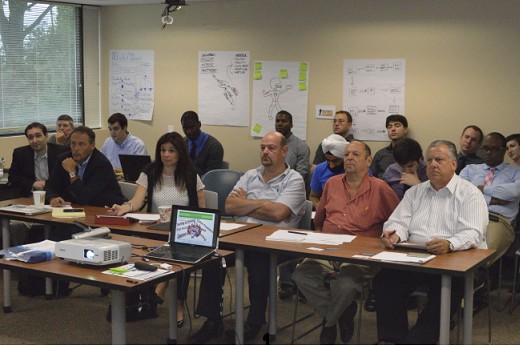TechLaunch Startups Evolve Through Candid Feedback at Demo Day Practice, Part 1

On Sept. 5, 2012, 10 TechLaunch startups, very early in their evolution into ongoing concerns, practiced their Demo Day pitches before six seasoned investors, advisers and entrepreneurs.
In Part 1 of this story, NJTechWeekly.com will discuss the overall day’s message and share examples of what the companies were advised. In Part 2 we’ll continue to cover the advice given the companies.
TechLaunch, located at Montclair State University, is N.J.’s tech accelerator, formed with assistance from the New Jersey Economic Development Authority (EDA) and several angel investors to jumpstart the Garden State tech startup ecosystem.
The pitch session was more than just a pitch session, however. Companies gained valuable advice about not only how their slideshow looked but where they were headed, from advisers and mentors who know what investors require.
The adviser panel at this pitch session included veteran industry executive Bob Barbiere; serial entrepreneur and investor Mike Ajnsztajn; angel, consultant and professor Gina Tedesco; entrepreneur-turned-angel-investor and business adviser Joel Cartun; TapFame cofounder and CEO Satjot Sawhney; and TechLaunch founder and general partner Mario Casabona. TechLaunch executive director Travis Kahn sat in on the session and offered his insights.
Mary Howard, the program manager, who teaches entrepreneurship at Parsons The New School for Design (New York) and is a resident entrepreneur NJIT (Newark), kept the event flowing and helped keep track of the panel’s comments to further guide the companies.
Observers were told to expect that business plans would continue to develop, since practice for Demo Day was occurring fairly early in the companies’ history, after only a few weeks of the 12-week program. Some general advice given to all participants:
- You have about 30 seconds to catch the investors’ attention, so get right to the problem and how you fill the void.
- If you have paying users, tell the investors right away. They will take you more seriously.
- Be enthusiastic about your product and demonstrate that enthusiasm in the presentation.
- If you are nervous, don’t show it.
- If you have an “emotional” product, be emotional when presenting it.
- Take some pauses to let investor’s absorb what you’ve shown them and vary your voice tones so your audience doesn’t zone out.
- Slides represent the brand, so decide on a look, feel and even a font for slides that represent you as a brand. Don’t misspell anything. Black-and-white slides don’t capture viewers’ attention. Use a sharp, high-definition logo.
- If your product is a website, you must show how you will drive people to that site and acquire users.
- Never present a live demonstration; it’s a killer. But it’s effective to use video to demo the company’s story.
The panel had specific ideas about how the startups could improve their businesses and presentations:
Addressing presenter Jeffrey Duperval of QuickCliqs, which is developing a mobile app aimed at 17- to 25-year-olds to take the stress out of planning get-togethers with friends, Cartun said the company needed to better explain the current status of development and how it would obtain revenue. Casabona added that from the presentation it wasn’t clear that the company would have available on launch all the features Duperval had discussed. He suggested changing the slides to indicate which features would be available when. Barbiere commented that the pitch needed revising to address a more experienced audience. And he said, “Talk about your team, give their backgrounds, make me believe this is one heck of a team!” 
Brian Donahue from Echolocation, a hyperlocal microblogging solution whose monetization strategy involves advertising, mentioned that his team was gearing up to make a splash at South by Southwest, the conference that launched Twitter and Foursquare. Casabona asked, “What happens if you don’t do well there?” noting that a company’s entire marketing plan can’t hinge on one event. Tedesco urged that the company’s slides show the relationship between the product and its users, while Ajnsztajn said it wasn’t clear how Echolocation was going obtain the number of users needed to make it successful and attractive to advertisers.
Presenting for NuSkool, Abran Maldonado noted that his company combines pop culture and entertainment and converts them to educational modules for classrooms. Many modules will be licensed from producers according to this scenario, but the company was urged to review its expenses slide carefully to ensure it accurately factors in high royalty costs. The monetization strategy also involves teachers paying for modules, and the panel questioned whether they would be willing to do so. When Maldonado mentioned including advertising in the modules, most presenters said that this was a bad idea, saying people don’t like advertising to children, though it’s been done. Cartun said having a pilot in a couple of classrooms, so the company could collect teacher testimonials, would be a good way to validate the business.

